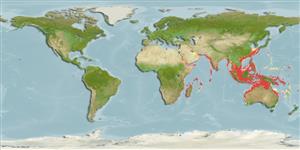Common names from other countries
>
Tetraodontiformes (Puffers and filefishes) >
Diodontidae (Porcupinefishes (burrfishes))
Etymology: Cyclichthys: Greek, kyklos = round + Greek, ichthys = fish (Ref. 45335).
More on author: Bloch.
Environment: milieu / climate zone / depth range / distribution range
Ecología
marino asociado a arrecife; rango de profundidad 9 - 170 m (Ref. 30573). Tropical; 32°N - 36°S, 24°E - 168°E
Indo-West Pacific: Red Sea and East Africa to the Philippines, north to southern Japan, south to Australia and New Caledonia (Ref. 9680). Southeast Atlantic: south coast of South Africa (Ref. 4423).
Tamaño / Peso / Age
Maturity: Lm ? range ? - ? cm
Max length : 30.0 cm TL macho / no sexado; (Ref. 9710)
Short description
Morfología | Morfometría
Espinas dorsales (total): 0; Radios blandos dorsales (total): 11-13; Espinas anales 0; Radios blandos anales: 10 - 12. Adults brown to grey with blotches and clusters of black spots on back and sides; pelagic juveniles covered with black spots (Ref. 4423).
Inhabit clear protected reefs with sponge and algal habitats. Often in large sponges during the day (Ref. 48637). Usually over sand and mud bottoms to at least 170 m (Ref. 30573). Occasionally on reefs (Ref. 9680). Active at night, feeding among reefs (Ref. 48637). A nocturnal species (Ref. 9710) that presumably feeds on hard-shelled invertebrates (Ref. 9680, 48637).
Life cycle and mating behavior
Madurez | Reproducción | Puesta | Huevos | Fecundidad | Larva
Randall, J.E., G.R. Allen and R.C. Steene, 1990. Fishes of the Great Barrier Reef and Coral Sea. University of Hawaii Press, Honolulu, Hawaii. 506 p. (Ref. 2334)
IUCN Red List Status (Ref. 130435)
CITES (Ref. 128078)
Not Evaluated
Threat to humans
Harmless
Human uses
Pesquerías: pesquerías de subsistencia; pesca deportiva: si
Más información
ReferenciasAcuiculturaPerfil de acuiculturaRazasGenéticaElectrophoresesheritabilidadEnfermedadesProcesamientoMass conversion
Herramientas
Special reports
Download XML
Fuentes de Internet
Estimates based on models
Preferred temperature (Ref.
115969): 22.3 - 28.3, mean 26.8 (based on 908 cells).
Phylogenetic diversity index (Ref.
82804): PD
50 = 0.6250 [Uniqueness, from 0.5 = low to 2.0 = high].
Bayesian length-weight: a=0.04786 (0.01967 - 0.11644), b=2.82 (2.61 - 3.03), in cm Total Length, based on LWR estimates for this (Sub)family-body shape (Ref.
93245).
Nivel trófico (Ref.
69278): 3.6 ±0.59 se; based on food items.
Resiliencia (Ref.
120179): Alto, población duplicada en un tiempo mínimo inferior a 15 meses (Preliminary K or Fecundity.).
Fishing Vulnerability (Ref.
59153): Low vulnerability (20 of 100).
